Display Type Dialog
The Display Type dialog helps you to define the display type of an object. It appears when you right-click a label, data field, special field or basic web control in a report and select Display Type from the shortcut menu.
The display type can be one of the following depending on the type of the report containing the object and the type of the object itself:
- Text
- Image
- Barcode
- QR Code
- Rank
- Text Field
- Hidden Field
- Text Area
- Checkbox
- Radio Button
- Image Button
- Button
- List
- Drop-down List
OK
Applies the changes and closes the dialog.
Cancel
Does not retain any changes and closes the dialog.
Apply
Applies all changes and leaves the dialog open.
Help
Displays the help document about this feature.
Note: The two display types - List and Drop-down List are only available when the data field is a parameter field, or when the web control is a List or Drop-down List.
Text
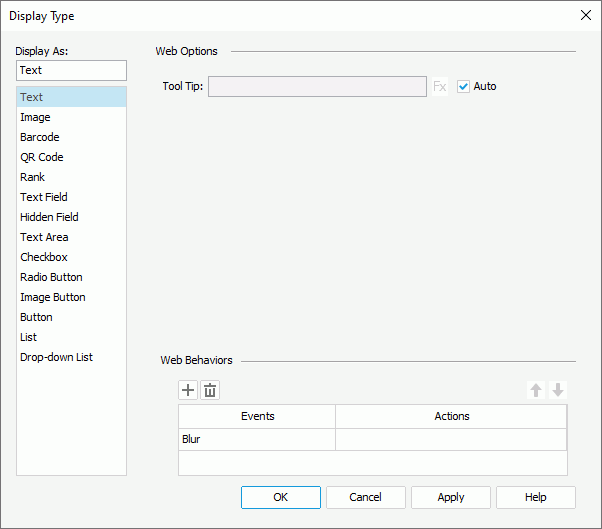
Tool Tip
Specifies the tooltip of the text, which will be shown when you hover the mouse over the text in HTML result or at server runtime.

Indicates the value of an option can be controlled by a formula or a DBField. Available to page reports that are created using query resources only.- Auto
When the Auto option is checked, the tooltip cannot be customized. Then in HTML result or at server runtime, when the text cannot be fully displayed, you can hover the mouse over the text to get its full content in the tooltip.
Specifies web behaviors to the text.

Adds a new web behavior line.
Removes the selected web behavior.
Moves the selected web behavior up a step.
Moves the selected web behavior down a step.- Events
Specifies the trigger event. - Actions
Specifies the web action you want the event to trigger.
Opens the Web Action List dialog to bind some web action to the event.
Image

Source
Specifies where the image you want to use comes from.
- From URL
Specifies to use an image from a URL. You can select the Browse button to specify the path or input the URL directly in the text box. These types of images are supported: GIF, BMP, JPG and PNG. - From DBField
Specifies whether to make the current data field the image source. Available for a DBField, formula or summary.- Decode Type
Specifies the type for decoding the image. It can be GIF or JPG, Bitmap, SVG, Auto Detect (this is to detect an image type saved in the database automatically). - Data URI Scheme
Specifies whether to parse the image using the data URI scheme.
- Decode Type
Name
Specifies the name of the image. You can input the name directly in the text box or use a formula to control it.
Alternate Text
Specifies the alternate text of the image, which will be shown when the image cannot be displayed.
Tool Tip
Specifies the tooltip of the image, which will be shown when you hover the mouse over the image in HTML result or at server runtime.

Indicates the value of an option can be controlled by a formula or a DBField.
Specifies the size of the image. Disabled when From DBField is selected and Decode Type is SVG.
- Original Size
Specifies whether to use the original size of the image. This will give you the best results when the image is already the size you want to display and is more efficient than scaling the image every time the report runs. - Constrain Proportions
If checked, when you set the display width or height of the image, the other will be adjusted accordingly based on the image's width-to-height ratio. Available only when the Original Size option is unchecked. - Width
Specifies the new display width of the image. Available only when the Original Size option is unchecked. - Height
Specifies the new display height of the image. Available only when the Original Size option is unchecked. - Scaling Mode
Specifies the scaling mode of the image. Available only when the Original Size option is unchecked. There are five types available for you:- actual size
If selected, the image will be shown in its actual size. - fit image
If selected, the image will be scaled to be wholly shown. - fit width
If selected, the image will be scaled to fit the width of the image viewer. - fit height
If selected, the image will be scaled to fit the height of the image viewer. - customize
If selected, the image will be scaled according to the width and height that you specify in the Width and Height boxes.
- actual size
- Max Ratio
Specifies the maximum scaling ratio of the image. By default the scaling ratio of the image is not limited. If it is set to any value greater than 0, the actual scaling ratio will be less than or equal to it. - Rotation
Specifies the angle, at which to rotate the image, in degrees. The following is the meaning of different values:- 0 - No rotation.
- Positive value - Rotates the image clockwise.
- Negative value - Rotates the image anticlockwise.
Note: When rotating an image, the rectangle that holds the image maintains its original size, which may result in that the image exceeds the field border and therefore the parts that extend outside of the border will be cut off.
Specifies web behaviors to the image.
Barcode
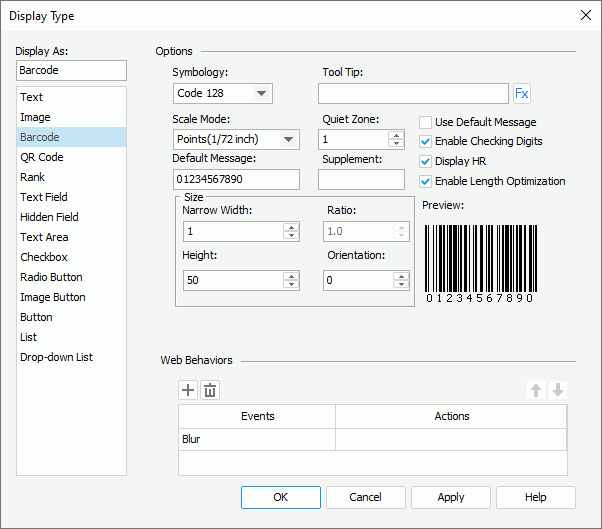
Symbology
Specifies the type of the barcode. It could be UPC A/E, EAN 13/8, CODE 39, CODE 128, CODabar, and Code 128A/128B/128C.
Tool Tip
Specifies the tooltip of the barcode, which will be shown when you hover the mouse over the barcode in HTML result or at server runtime. You can also use a formula to control the tooltip.
Scale Mode
Specifies the unit for the values of Quiet Zone, Narrow Width, Supplement, Height and Ratio.
Quiet Zone
Specifies the space around the barcode.
Default Message
Specifies the default value for the barcode, which will be used for the barcode in design mode.
Supplement
Specifies the supplement for the barcode. The barcode types, Code 39, Code 128/128A/128B/128C and Codabar, don't have supplements.
Use Default Massage
If checked, the value you specify in the Default Message text box will be used as the barcode value when you view the report result. Otherwise, the value will only be used in design mode.
Enable Checking Digits
Specifies whether to include check digits in the barcode.
Display HR
Specifies whether to display the barcode numbers together with the barcode. Enabled only for Code 39, Code 128/128A/128B/128C and Codabar.
Enable Length Optimization
Specifies whether to enable optimizing the length of the barcode in the report result. Available to Code 128 only.
Size
Specifies the size of the barcode.
- Narrow Width
Specifies the width between the barcode bars. - Ratio
Specifies the width ratio of the thick bar to the thin bar in the CODE39/Codabar barcode. The Ratio box can have only 2 effective values, 2.0 and 3.0, any ratio values are not equal to 2.0 or 3.0 will be granted as 2.0. Enabled only for CODE39 and Codabar. - Height
Specifies the height for the bars of the barcode. - Orientation
Specifies the orientation for the barcode.
Preview
Displays the format of the selected symbology.
Specifies web behaviors to the barcode.
QR Code
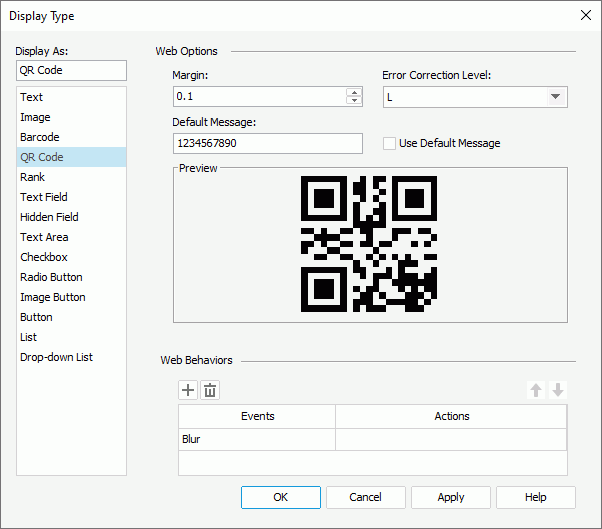
Margin
Specifies the margin between the image in the middle of the QR Code and the border of the QR Code.
Error Correction Level
Specifies the level of error correction for the QR Code: L, M, Q or H.
Default Message
Specifies the default value for the QR Code.
Use Default Massage
Specifies to generate the QR Code using the default value.
Preview
Displays a preview of the QR Code.
Specifies web behaviors to the QR Code.
Rank

Default Image for All Value Ranges
Specifies the default image for all value ranges, which will be applied when the value of a field does not fall into any of the defined ranges. You can select the Browse button to specify the image path or input the path and file name of the image directly in the text box.
Default Image Alternate Text
Specifies the alternate text for the default image, which will be shown when the default image cannot be displayed.
Default Tool Tip
Specifies the tooltip of the default image, which will be shown when you hover the mouse over the image in HTML result or at server runtime.

Indicates the value of an option can be controlled by a formula or a DBField.
Default Image Rotation
Specifies the default image's rotation angle, in degrees. The following is the meaning of different values:
- 0 - No rotation.
- Positive value - Rotates the image clockwise.
- Negative value - Rotates the image anticlockwise.
Note: When rotating an image, the rectangle that holds the image maintains its original size, which may result in that the image exceeds the field border and therefore the parts that extend outside of the border will be cut off.
Value Range
Specifies the value ranges.

Adds a new value range.
Removes the selected value range.
Moves the selected value range up a step.
Moves the selected value range down a step.- Minimum (>=)
Specifies the minimum value for this range. - Maximum (<)
Specifies the maximum value for this range. - Image
Specifies the image of this value range, then when a field's value falls into this range, this image will be displayed. - Alternate Text
Specifies the alternate text for this value range's image, which will be shown when the image cannot be displayed. - Tool Tip
Specifies the tooltip of this value range's image, which will be shown when you hover the mouse over the image when the report runs in HTML format or in Page Report Studio. - Rotation
Specifies the rotation angle of this value range's image, in degrees.
Specifies web behaviors to the rank.
Text Field
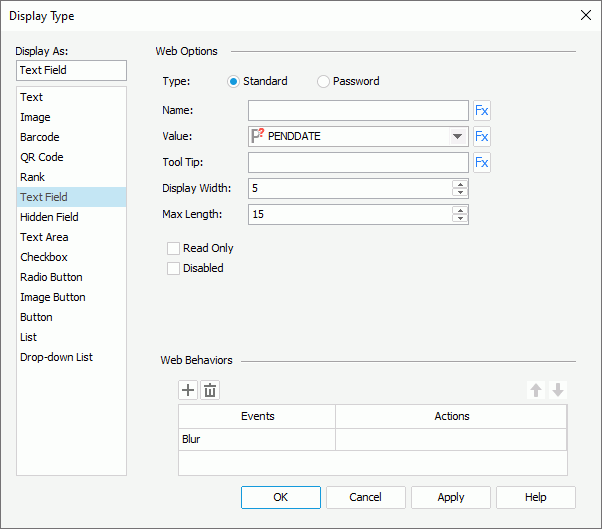
Type
Specifies the type of the text field.
- Standard
Specifies that the text field is a standard text field. - Password
Specifies that the text field is a password text field, which means that the value input in the text field will be hidden using asterisks.
Name
Specifies the name of the text field.
Value
Specifies the value of the text field.
Tool Tip
Specifies the tooltip of the text field, which will be shown when you hover the mouse over the text field in HTML result or at server runtime.

Indicates the value of an option can be controlled by a formula or a DBField. Available to page reports that are created using query resources only.
Display Width
Specifies the display width of the text field.
Max Length
Specifies the maximum length of the string that is allowed in the text field.
Read Only
Specifies whether to make the field read-only to others.
Disabled
Specifies whether the text field is disabled or enabled.
Specifies web behaviors to the text field.
Hidden Field
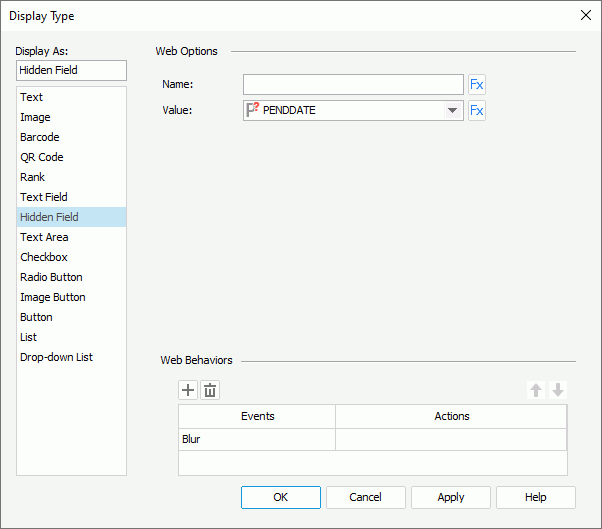
Name
Specifies the name of the hidden field.
Value
Specifies the value of the hidden field.

Indicates the value of an option can be controlled by a formula or a DBField.
Specifies web behaviors to the hidden field.
Text Area
The following are details about options for this display type.
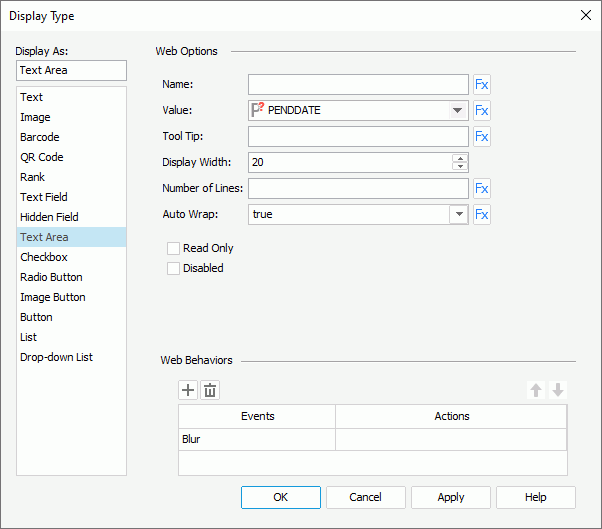
Name
Specifies the name of the text area.
Value
Specifies the value of the text area.
Tool Tip
Specifies the tooltip of the text area, which will be shown when you hover the mouse over the text area in HTML result or at server runtime.
Display Width
Specifies the display width of the text area.
Number of Lines
Specifies the number of lines that is allowed in the text area.
Auto Wrap
Specifies whether to wrap the text in the text area.

Indicates the value of an option can be controlled by a formula or a DBField. Available to page reports that are created using query resources only.
Read Only
Specifies whether to make the text area read-only to others.
Disabled
Specifies whether the text area is disabled or enabled.
Specifies web behaviors to the text area.
Checkbox
The following are details about options for this display type.
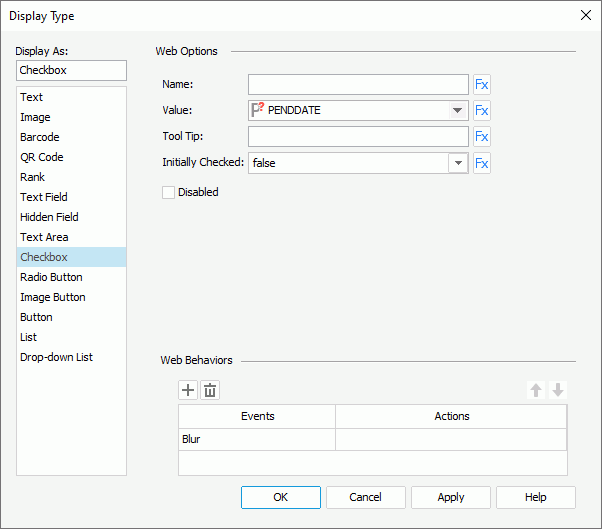
Name
Specifies the name of checkbox.
Value
Specifies the value of the checkbox.
Tool Tip
Specifies the tooltip of the checkbox, which will be shown when you hover the mouse over the checkbox in HTML result or at server runtime.
Initially Checked
Specifies whether or not the checkbox is selected by default.

Indicates the value of an option can be controlled by a formula or a DBField. Available to page reports that are created using query resources only.
Disabled
Specifies whether the checkbox is enabled or disabled.
Specifies web behaviors to the checkbox.
Radio Button
The following are details about options for this display type.
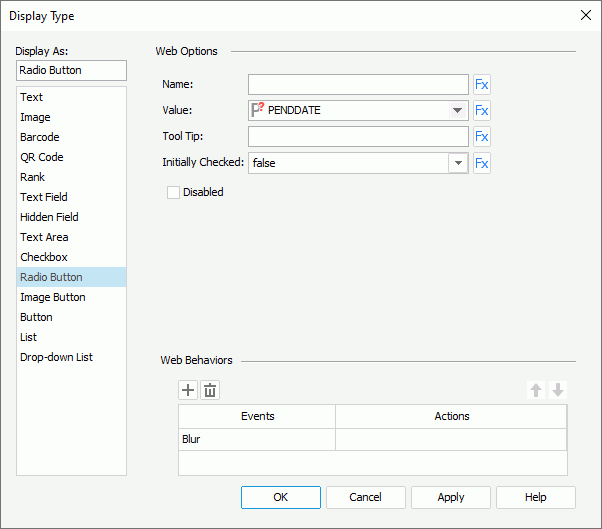
Name
Specifies the name of radio button.
Value
Specifies the value of the radio button.
Tool Tip
Specifies the tooltip of the radio button, which will be shown when you hover the mouse over the radio button in HTML result or at server runtime.
Initially Checked
Specifies whether or not the radio button is selected by default.

Indicates the value of an option can be controlled by a formula or a DBField. Available to page reports that are created using query resources only.
Disabled
Specifies whether the radio button is enabled or disabled.
Specifies web behaviors to the radio button.
Image Button
The following are details about options for this display type.
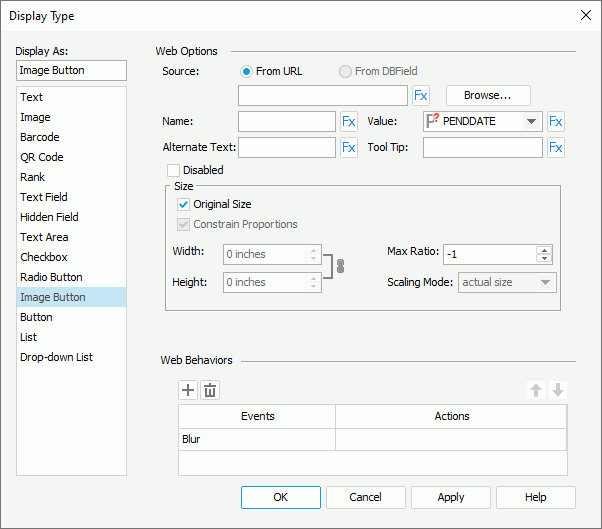
Source
Specifies where the image button you want to use comes from.
- From URL
Specifies to use an image from a URL. You can select the Browse button to specify the path or input the URL directly in the text field. These types of images are supported: GIF, BMP, JPG, and PNG. - From DBField
For a DBField, formula, or a summary, you can check this option to make the value of the DBField/formula/summary the image source.- Decode Type
Specifies the type for decoding the image. It can be GIF or JPG, BITMAP, AUTODETECT (this is to detect an image type saved in the database automatically).
- Decode Type
Name
Specifies the name of the image button.
Value
Specifies the value of the image button.
Alternate Text
Specifies the alternate text of the image, which will be shown when the image cannot be displayed.
Tool Tip
Specifies the tooltip of the image button, which will be shown when you hover the mouse over the image button in HTML result or at server runtime.

Indicates the value of an option can be controlled by a formula or a DBField. Available to page reports that are created using query resources only.
Disabled
Specifies whether the image button is disabled or enabled.
Size
Specifies the size of the image.
- Original Size
Specifies whether to use the original size of the image. This will give you the best results when the image is already the size you want to display and is more efficient than scaling the image every time the report runs. - Constrain Proportions
If checked, when you set the width or height of the image, the other will be adjusted accordingly based on the image's width-to-height ratio. Available only when the Original Size option is unchecked. - Width
Specifies the new display width of the image. Available only when the Original Size option is unchecked. - Height
Specifies the new display height of the image. Available only when the Original Size option is unchecked. - Max Ratio
Specifies the maximum scaling ratio of the image. By default the scaling ratio of the image is not limited. If it is set to any value greater than 0, the actual scaling ratio will be less than or equal to it. - Scaling Mode
Specifies the scaling mode of the image. Available only when the Original Size option is unchecked. There are five types available for you:- actual size
If selected, the image will be shown in its actual size. - fit image
If selected, the image will be scaled to be wholly shown. - fit width
If selected, the image will be scaled to fit the width of the image viewer. - fit height
If selected, the image will be scaled to fit the height of the image viewer. - customize
If selected, the image will be scaled according to the width and height that you specify in the Width and Height fields.
- actual size
Specifies web behaviors to the image button.
Button
The following are details about options for this display type.

Name
Specifies the name of the button.
Value
Specifies the value of the button.
Tool Tip
Specifies the tooltip of the button, which will be shown when you hover the mouse over the button in HTML result or at server runtime.

Indicates the value of an option can be controlled by a formula or a DBField. Available to page reports that are created using query resources only.
Action
Specifies the default action that will happen when the button is selected.
- None
Specifies that no default action happens when the button is selected. - Submit Form
Specifies that the default action of the button is to submit a form. - Reset Form
Specifies that the default action of the button is to reset a form.
Disabled
Specifies whether the button is disabled or enabled.
Specifies web behaviors to the button.
List
The following are details about options for this display type.
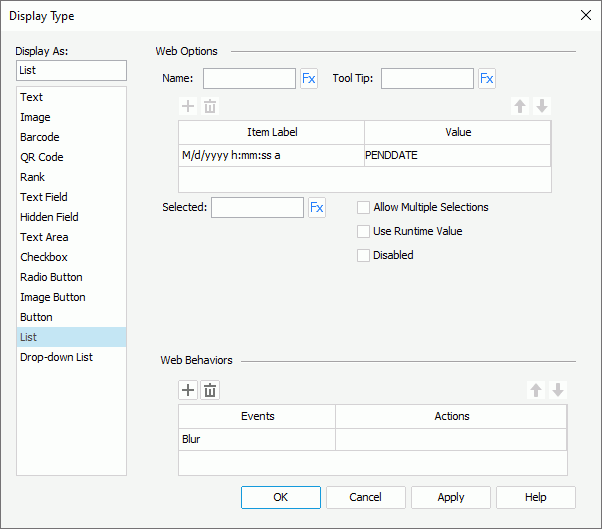
Name
Specifies the name of the list.
Tool Tip
Specifies the tooltip of the list, which will be shown when you hover the mouse over the list in HTML result or at server runtime.

Adds a new item in the list.

Removes the selected item.

Moves the selected item up a step.

Moves the selected item down a step.
Item Label
Specifies the display text or format of the item value. Select the desired one from the drop-down list.
Value
Specifies the item value.

Opens the Insert Fields dialog to add field to control the value.
Selected
Specifies the value that will be selected in the list by default.

Indicates the value of an option can be controlled by a formula or a DBField. Available to page reports that are created using query resources only.
Allow Multiple Selections
Specifies whether to allow selecting multiple items in the list at the same time.
Use Runtime Value
When changing the display type of a parameter to list, you can check this option to use the runtime value as the selected value of the list.
Disabled
Specifies whether the list is disabled or enabled.
Specifies web behaviors to the list.
The following options are available when the object is in a web report or library component:
Display
Specifies whether the list is displayed as Text, Button, Checkbox or Radio Button. When Radio Button is selected, the Allow Multiple Selections option above is disabled.
Vertical
Lists items in one column vertically. When there is not enough height, the scrollbar will appear.
Horizontal
Lists items horizontally following the Z order.
Item Width
Specifies the width of each item in the list. Disabled when Vertical is selected.
Item Height
Specifies the height of each item in the list.
Horizontal Gap
Specifies the horizontal gap between two adjacent items in the list. Disabled when Vertical is selected.
Vertical Gap
Specifies the vertical gap between two adjacent items in the list.
Drop-down List
The following are details about options for this display type.
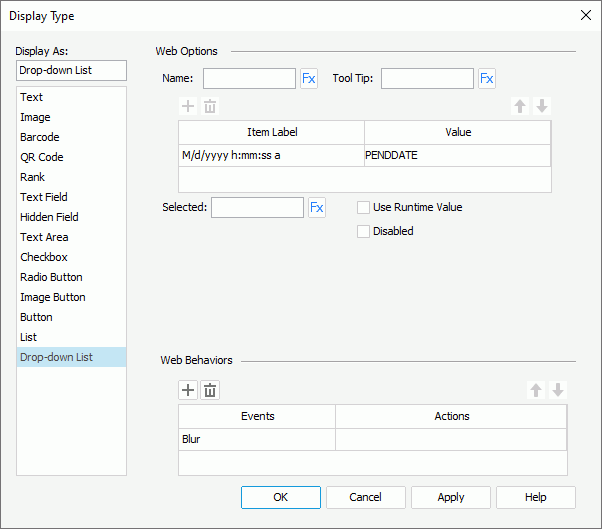
Name
Specifies the name of the drop-down list.
Tool Tip
Specifies the tooltip of the drop-down list, which will be shown when you hover the mouse over the drop-down list in HTML result or at server runtime.

Adds a new item in the drop-down list.

Removes the selected item.

Moves the selected item up a step.

Moves the selected item down a step.
Item Label
Specifies the display text or format of the item value. Select the desired one from the drop-down list.
Value
Specifies the item value.

Opens the Insert Fields dialog to add field to control the value.
Selected
Specifies the value that will be selected in the drop-down list by default.

Indicates the value of an option can be controlled by a formula or a DBField. Available to page reports that are created using query resources only.
Use Runtime Value
When changing the display type of a parameter to drop-down list, you can check this option to use the runtime value as the selected value of the drop-down list.
Disabled
Specifies whether the drop-down list is disabled or enabled.
Specifies web behaviors to the drop-down list.
 Previous Topic
Previous Topic